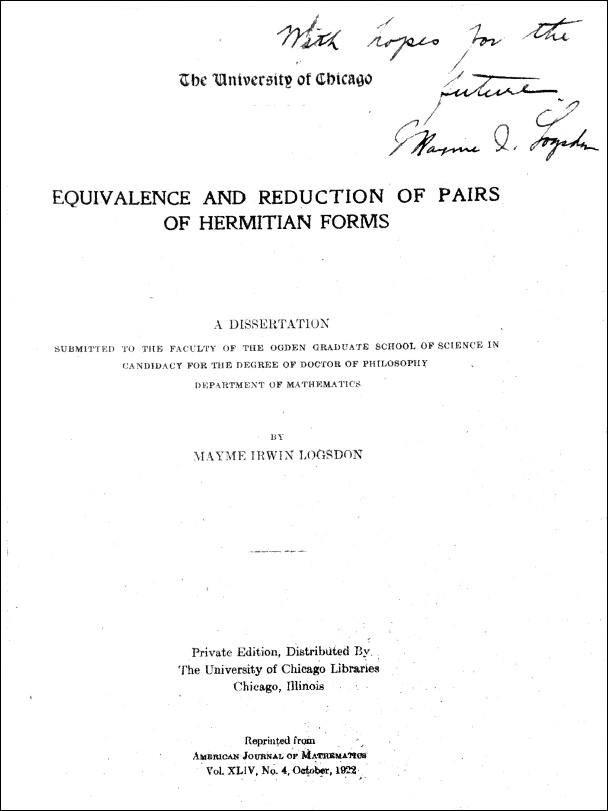Mayme Irwin Logsdon
Equivalence and
Reduction of Pairs of Hermitian Forms
American Journal of
Mathematics, Vol. 44 (1922), 247-260.

Introduction and Summary.--Of fundamental importance in the theory of matrices and forms has been the use by Weierstrass, Kronecker, and Frobenius of the theory of elementary divisors in the study of equivalence and reduction of pairs of bilinear and pairs of quadratic forms.
In this paper a generalization is made in that the basal theorems of the theory are extended to any hermitian λ-matrix, i.e., a matrix whose elements are polynomials of degree n in λ with coefficients in the field of complex numbers and are such that the conjugate of the elements in the ith row and jth column is equal to the element in the jth row and the ith column for i,j = 1,2,...,n.
Inasmuch as a linear substitution with matrix P on the variables of an hermitian form with matrix a gives a form with matrix b = conj(P')*a*P where conj(P) means the matrix formed from P by taking the conjugate imaginary of each element and P' means the transposed matrix P, the extension of the general theory to the hermitian λ-matrix is justified by the proof in part I of
Theorem II. If b = conj(p')*a*q where p and q are non-singular and independent of λ, and where a and b are hermitian λ-matrices, then there exists a matrix P such that b = conj(P')*a*P.
The special application is made to hermitian λ-matrices whose elements are linear in λ. Such will be the matrix of the pencil of forms \[\lambda A-B = \sum_{i=1}^n \sum_{j=1}^n (\lambda a_{ij} - b_{ij})\overline{x_i}x_j\] The coincidence of the elementary divisors is found to be a necessary and sufficient condition for the equivalence of two pairs of hermitian matrices free of λ and for the equivalence of two pairs of hermitian forms.
In part II, the Weierstrass reduction is shown to hold in case one of the forms is definite, a condition which insures reality of all the elementary divisors; in fact the Weierstrass method can be used for finding the contribution to the canonical form of any real elementary divisor. In the case however of conjugate complex elementary divisors, (λ–conj(a))e and (λ–a)e, it was found necessary and and possible to regularize the λ-matrix with respect to the two conjugate imaginary linear factors simultaneously and also to expand the terms representing the adjoint form with respect to these two factors simultaneously.
In the actual work of reduction use was made of an algebraic simplification suggested and described by Dickson in "Pairs of Bilinear or Quadratic Forms." The importance of this simplification is that in the case of bilinear forms the reduction may be accomplished rationally while in the case of quadratic or hermitian forms the computations are simplified if the constants which appear are held until the last step of the reduction before being absorbed in the variables.
